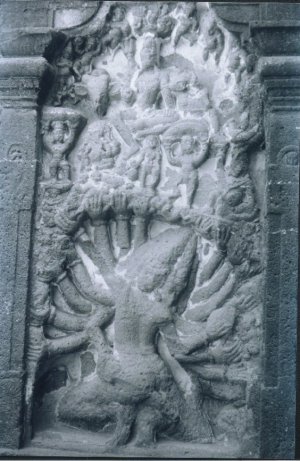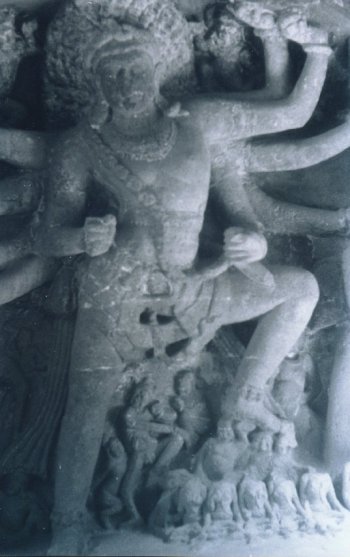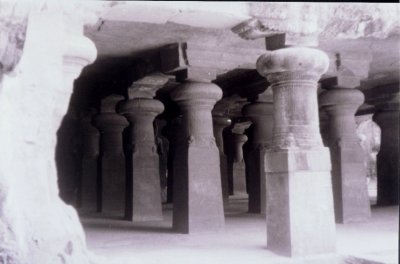Art and Architecture under the Rashtrakutas
by Dr. Jyotsna Kamat
First Online: April 15, 2005
Page Last Updated: December 07, 2024
Two and a half century of Rashtrakuta rule, witnessed very high achievement in the field of sculpture and architecture. Now after more than a millennium whatever remains, is in dilapidated condition. Even then, Ellora and Elephanta caves provide splendid examples of that era which excelled in carving out huge monuments and monolithic sculptures. In Ellora (in Maharashtra), we have rock-cut cave-temples of all faiths then flourishing in India. Buddhist, Jaina, Shaiva and Vaishnava. Out of the thirty four caves twelve are Buddhist, (in the South) seventeen are Hindu (Vaishnava Shaiva and Shakta) and five caves on the northern side are Jaina.
Buddhistic architecture necessitated big Chaitya hall unobstructed by columns to accommodate big congregations and to offer mass prayers. Chaitya halls in Ajanta and Kanheri are such constructions. The Chaitya caves in Ellora signify a passing phase. Gigantic columns appear in front of the sanctum sanctorum where Buddha's image used to be installed.
K.L. Kamat/Kamat's Potpourri
Shiva and Rawana
Sculpture from Ellora shows Shiva suppressing the multi-headed, multi-armed Rawana
The Indrasabha and Jagannatha Sabha in four Jaina caves which contain images of Gommata, Shatinatha and Parshvanatha and Mahaveera are as magnificent as other structures which are Brahmanical. Shiva in Tandava dance is in rare atibhanga pose balanced delicately by four hands on eachside. The colossal image of river Ganga is described as last word in grace, dignity and poise. The Dhumar Lena (cave) of Ellora has striking resemblance to Elephanta cave-sanctuary. Dr. Burgess compared it to an Egyptian monument in majestic grandeur. The wedding scene of Shiva Parvati provides a visual representation of some immortal verses of Kumarasambhava epic of Kalidasa.
K.L. Kamat/Kamat's Potpourri
The Lord of Kailash
Kailash temple, Ellora
Cut out of a single rock the Kailas temple is an example of superb skill. The ground plan of this temple approximates in area that of the Parthenon of Athens and its height is one and a half time of the same Greek masterpiece. Percy Brown felt that it was a great spiritual achievement. "An illusion of one of those rare occasions when men's minds, hearts and hands worked in unison towards the consummation of a supreme ideal" he wrote.
The theme of Rawana (see also: Mr. Ten Heads -- Depiction of king Rawana in various forms of Indian art.) shaking the Kailasa mountain, Shiva-tandava, Shiva-Parvati playing chess are a favorite theme of sculptors of Ellora, Shiva Parvati figure along with ganas and different deities.
K.L. Kamat/Kamat's Potpourri
A View of a Cave Complex, Elephanta
Elephanta Island near Mumbai has Ardhanarishwara panel which is badly mutilated. The Portuguese had occupied it for sometime and as was their custom, they have destroyed many sculptures. The Trimurti or representation of Brahma, Vishnu and Maheshwara is stupendous. The threefold image is twenty three feet high and nineteen and a half feet broad. "The grandest representation of the pantheist God ever made by the hands of man".
Elephanta, according to Sister Nivedita perpetuates the synthesis of Hinduism - "Three-in-one the Unity-in-Trinity".
Among Rashtrakuta rulers some had Shiva as their Titular deity, some had Vishnu and Amogavarsha Nrupatunga was a devout Jain. But inscriptions scattered throughout their vast empire bear witness to their munificent grants to Buddhism, Jaina, Shaiva and Vaishnava institutions. Keeping alive the great Indian tradition of religious toleration.
![]()
See Also:
- Ajanta and Ellora -- The caves of Ajanta and Ellora in Maharashtra are adorned with elaborate sculptures and paintings of an era that has long gone.
- Jainism Potpourri -- A brief introduction, artifacts and arts of Jains. Also a brief survey of Jain monuments.
- Cave Number 2, Ajanta and Ellora

